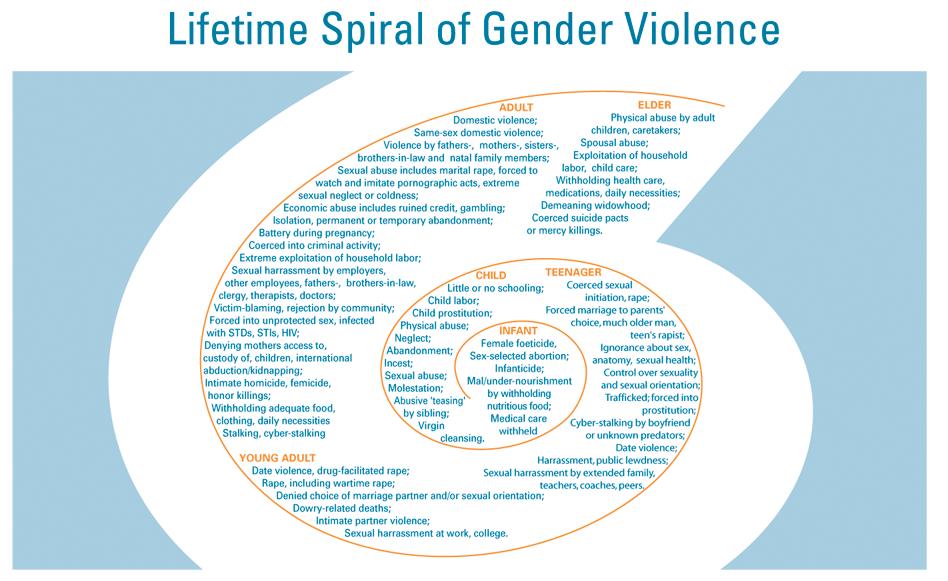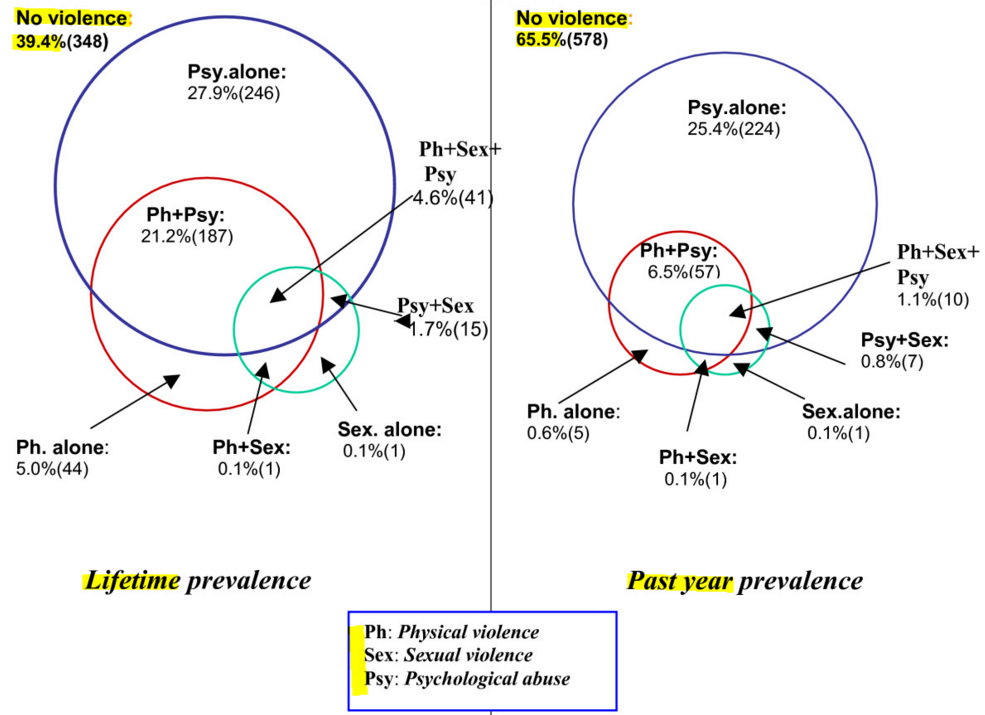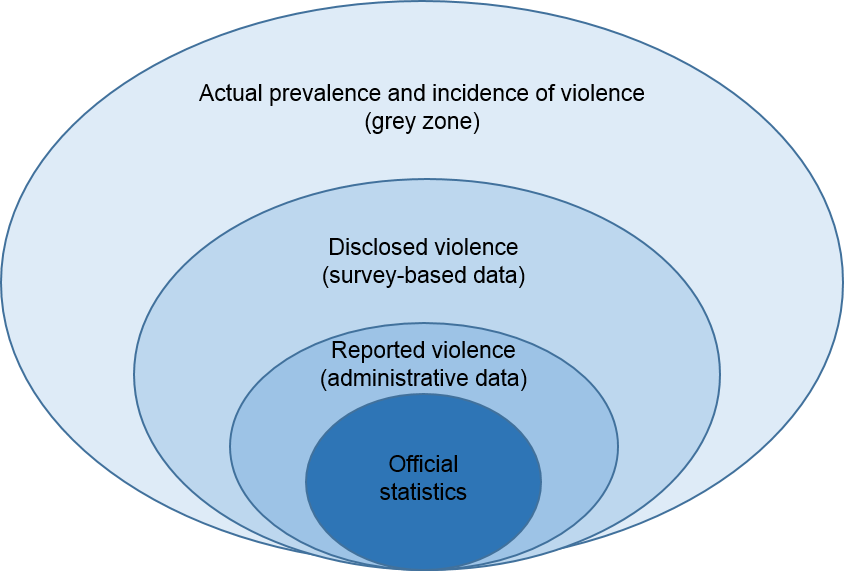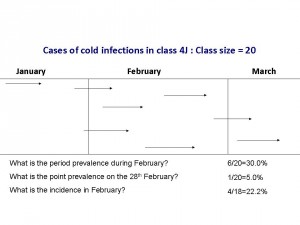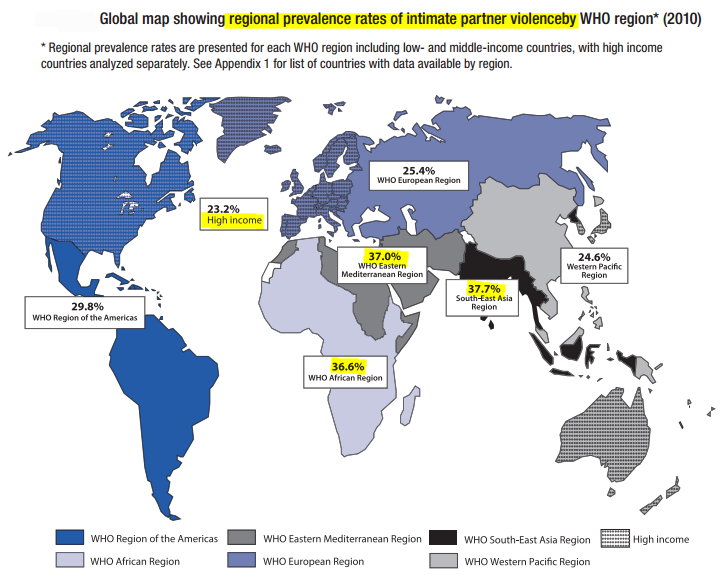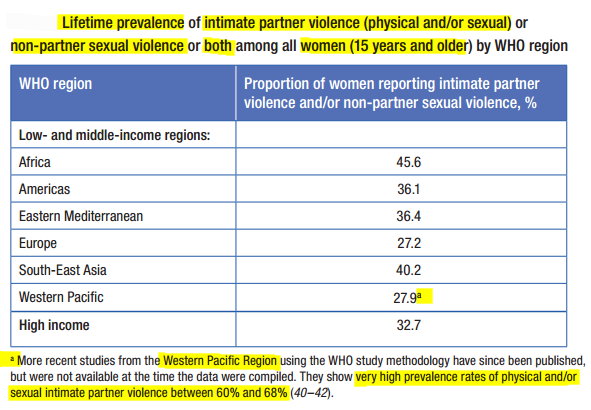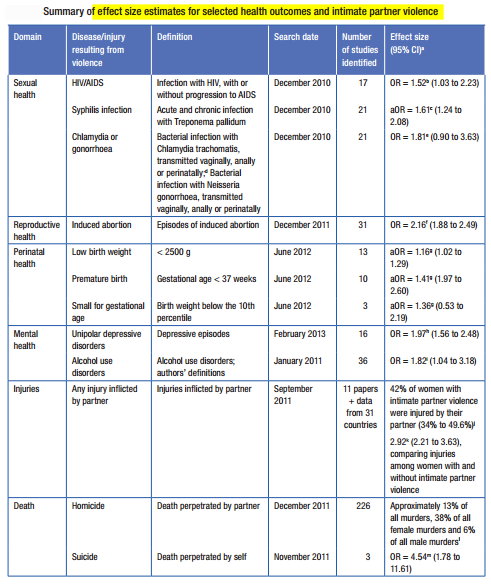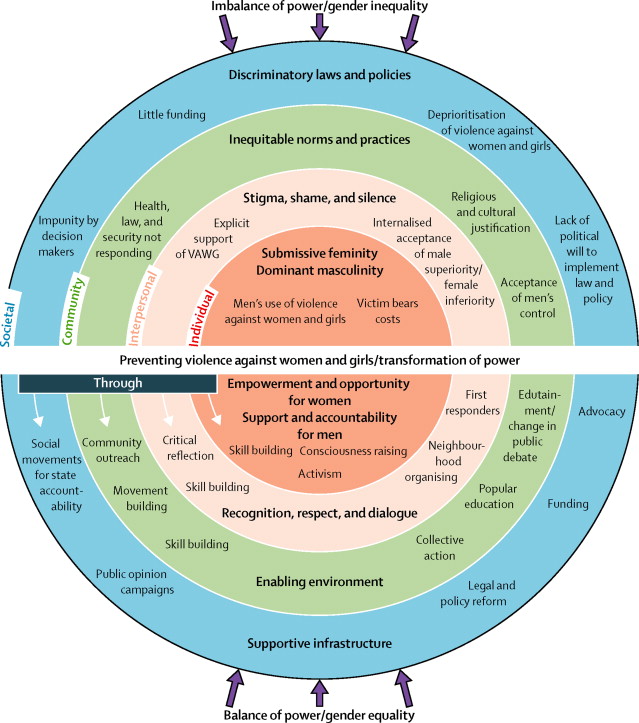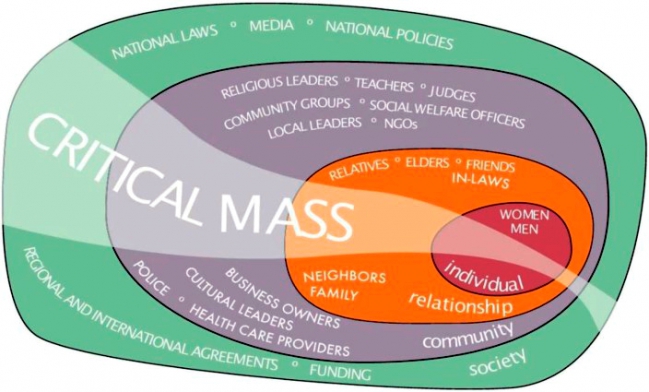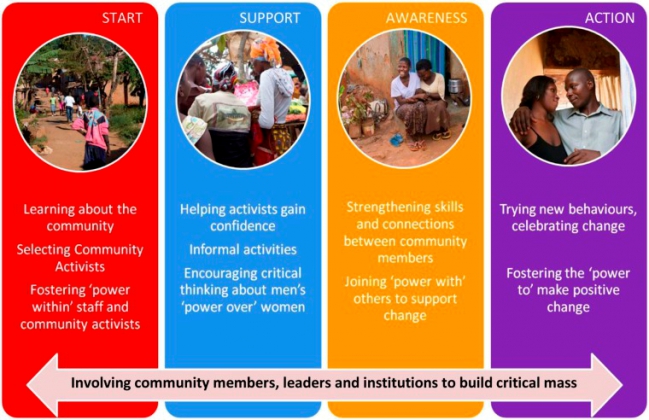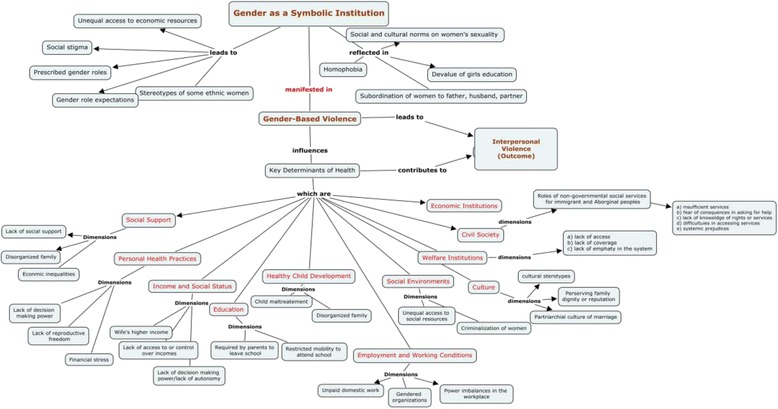Violence Against Women : An Introduction
SendThemPeace.com
...exists and is dedicated to reducing all forms of violence worldwide through non-violent means.
Areas lacking in Peace, are defined in our Targets category.
These are frequently countries with significant identifiable problems that create a difficult, or seemingly impossible milieu, for finding Peace.
But other categories than groups of countries, also suffer from violence or lack of Peace, and always linked to a lack of compassion.
One such troubling category is Violence Against Women.
One might quickly equate the topic with certain stereotypic ideas:
A woman returns home late from work. She is in a hurry to get home and makes a bad choice to cut through an alleyway.
She is accosted, beaten, knocked unconscious and raped, by a person she did not know, who was drinking alone in the alley.
Yes, that is one example of violence against another person, and in this case a woman.
Of course, globally, the problem is much larger.
So the intention here is to explore the topic a bit, and see what viewing the landscape of this problem reveals. What components of this Target, are added to our knowledge?
Is there a Gender difference?
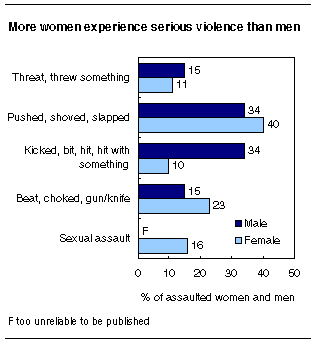
Let us begin by opening a small perspective on the problem...
At right, from a Province in Canada, one sees that both men and women are on the receiving end of violence. But clearly, victims of sexual violence, sorted by gender, do not permit a meaningful statistical analysis, because, well,... all victims in this limited study were female.
So women are at greater risk for sexual violence (we'll see this in more detail below), but is this violence limited globally to the type of stereotypic rape scene presented above, with an adult women suffering this victimization at a specific age in her life, by a perpetrator who is a stranger?
Absolutely not. Several components of that unfortunate example, are simply not "usual."
Violence Against Women has its own lifecycle.
Imagine if you can, that violence against women might begin when a woman is still an unborn foetus, and continues, with several potential and commonly witnessed stopping points, throughout her life, and even when she is elderly.
Certainly, certain offenses like child prostitution will be more quickly brought before the public eye, than simple and complete neglect of a child because she is female. It passes almost unobserved and unreported, varying greatly from one country to the next. Such variations by global region will reappear below in this introduction. Isn't completely neglecting a child, a form of intense psychological violence against her?
Summarizing this lifecycle of potential violence might look graphically like this :
~ click to enlarge the image ~
The above life path summary suggests that the types of violence to which women are exposed are not, of course, only sexual.
We open the window a bit wider on this topic, with a study of 883 married women ... Notice quickly, on the left that of these 883 women, 100-39.4% = 60.6%, or 535 reported experiencing psychological, physical, or sexual violence during their lifetime.
Think of violence against women not just as rape, but psychological and physical, as well as sexual. And clearly, there is an overlap that includes up to all three types. (Here given as 4.6%, for all three). The presumed major type of violence reported here is psychological. Is that less important, or in fact more difficult to "get over," than the other two types?
As we move towards components of this landscape that have data, numbers, statistics, reports and reporting, how reliable are the figures?
Frequently,... no, usually ...
... the values presented grossly understate, the actual prevalence.
Here is a graphic from a report on violence against women in Europe to complete this thought about underreporting.
What might contribute to underreporting?
A U.S. Perspective :
Let's open the window on this view a bit wider, and present some data from the US Justice Department. Clicking on the following link permits one to read and download this report here from SendThemPeace.com, about violence against women in the United States.
The intention here is to introduce more than to analyze fully, or even summarize, and the graphic data contained in the gallery below have that in mind. This is best viewed by clicking on the square of arrows icon to display full screen, then clicking arrows to scroll from one graphic to the next :
U.S. Summary
One of the results presented above : Type of assault (sample size = 8,000 women, and 8,000 men), and derived figures :
"This equates to an estimated 2.1 million U.S. women who are raped and/or physically assaulted annually. Because some rape and physical assault victims experience multiple victimizations per year, an estimated 876,000 rapes and 5.9 million physical assaults, or 6.8 million rapes and physical assaults combined, are committed against U.S. women annually."
How does this violence compare with auto accidents, or injuries sustained at work in the United States?
Rates of Violence-Related Injury and Accidental Injury
To place the injury and medical utilization estimates generated by the NVAW Survey in context, researchers compared the average annual injury victimization rate for women and men in the United States generated by the survey with the average annual rate of accidental injuries at work and the average annual rate of motor vehicle crash injuries for women and men in the United States. The combined average annual rate of rape and physical assault injury for women and men in the United States is 24 injury victimizations per 1,000 persons age 18 and older. This figure is derived by adding the estimated number of female rape victimizations and female and male physical assault victimizations that resulted in the victim being injured in the year preceding the survey, dividing this figure by the estimated number of women and men in the country who were age 18 and older at the time of the survey, and setting this figure to a population base of 1,000 [275,960 + 2,313,111 + 1,970,895 = 4,559,966 ÷ 193,445,000 = 0.0236 x 1,000 = 23.6].
In comparison the average annual rate of injury for a motor vehicle crash is 22 per 1,000 U.S. adults, and the average annual rate of accidental injury at work is 47 per 1,000 U.S. adults.
"Thus women and men in the United States are nearly equally likely to be injured during an automobile crash as by a rape or physical assault; however, they are nearly twice as likely to be injured on the job than during a rape or physical assault."
And how common is the problem globally ?
These data come from a World Health Organization study on Violence Against Women, which can be obtained in English at this link, or by downloading from our site by clicking here.
To better understand the data in this report, first a review of two terms:
Prevalence rate = The percentage of a population that is affected with a particular disease or condition at a given time.
Incidence rate = the rate of occurrence of new cases of a particular disease in a population being studied. So this too requires stating the period of time studied. Those displaying the disease or condition at the start of the study period, would not be counted, since they are not "new cases."
Prevalence is a measurement of all individuals affected by a disease or condition at a particular time, whereas incidence is a measurement of the number of new individuals who contract a disease or condition during a particular period of time.
Study the grapic below a bit, if you need more help with this difference. The example relates to colds in a class room, not violence :
Now we open the window wide enough to welcome in the Whole World.
To avoid getting lost in definitions, one example of "intimate partner violence" would be wife beating. Others are given elsewhere in this article.
So what was the prevalence rate in 2010 for this phenomenon, by global region, as reported by the World Health Organization? See below:
The WHO suggests that since 2010, these figures are increasing globally.
Lifetime prevalence rates of partner and non-partner violence against women, 15 years and older, by world region is tabulated below :
So this would include, for sake of simplified clarification, "wife beating," and "rape." Would you have guessed these figures?
Note also the difference between earlier and more recent study values for Western Pacific Region at footnote "a." A prevalance of 27.9% for the Western Pacific, suddenly becomes a "prevalence rate of physical and/ or sexual intimate partner violence of between 60% and 68%." What is the problem here? New and better data, finding a higher prevalence = a better estimate of actual prevalence due to underestimating.
This reminds one that study methodology and interval studied, can provide dramatic differences in data and conclusions.
So, do women just "get over" such violence by intimate partners, or are there health consequences, and how often?
~ click to enlarge the image ~
The results include Odds Ratios (OR), which may also benefit from a definition and quick explanation.
Def. : "An odds ratio (OR) is a measure of association between an exposure and an outcome. The OR represents the odds that an outcome will occur given a particular exposure, compared to the odds of the outcome occurring in the absence of that exposure."
These are usually presented followed by a range, like this : OR = 2.16 (1.88 to 2.49) which expresses, usually with 95% confidence, a range for the actual value. So from the Table, the odds for a woman undergoing an "Induced abortion" after "intimate partner violence" is on average 2.16 times the rate for a woman who has not suffered this violence, at a minimum, 1.88 times, and up to 2.49 times the rate of those without violence.
A few other figures catch one's attention.
"38% of all female murders, involve intimate partner violence."
Odds for suicide by a woman after intimate partner violence? OR = 4.54 (1.78 to 11.61).
Translation: a woman suffering "intimate partner violence" is on average 4.5 times more likely of commiting suicide, and up to 11.6 times more likely, than a woman who has not suffered this form of violence against women.
For non-partner sexual violence, simplified to "rape" for sake of presentation here :
"The fact that, in spite of the constraints to reporting, 7.2% of women globally have reported non-partner sexual violence provides important evidence of the extent of this problem. This review found that women who have experienced nonpartner sexual violence are 2.3 times more likely to have alcohol use disorders and 2.6 times more likely to have depression or anxiety than women who have not experienced non-partner sexual violence."
Conclusions of this WHO report :
Finding a Solution : Parts of the problem ...
Clearly, violence arising in relationships with intimate partners, are complicated by an investment (emotional, but others as well) in the relationship.
This can lead to cycles that are easier to understand than to interrupt and put en end to. "His" behavior presented here on the inside, and "her" behavior on the outside of this graphic :
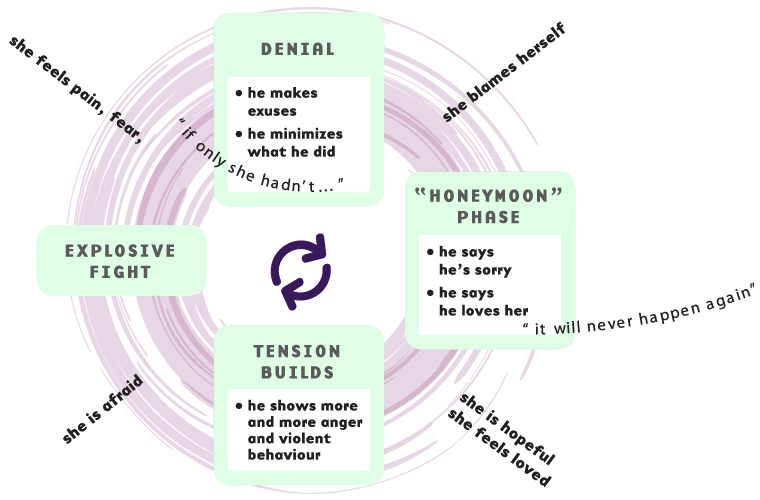
It is wrong to present this as a simple problem.
Can one risk to simplify this by suggesting that the primary problem contributing to Violence Against Women, is, well ... Men?
Surprisingly, not that much research has been done into mysoginistic attitudes that translate into men's hostile attitudes towards women.
Here is one such article that addreses this adherence of men to certain norms of masculinity that impede bringing compassion into relationships, and which constitute masculine gender role stress.
Here are at least some components of the problem and the solution.
In the graphic below, see the white horizontal line as the dividing line between: factors (above) that contribute to this Violence Against Women, and (below), those that could be or perhaps will become part of the solution.
The ease of implementation globally will not be uniform from one region to the next. In many ways, the higher the local prevalence of Violence Against Women, the less likely that the philosophy and infrastructure exist locally for creating solutions.
Clearly, some solutions arise from the discipline of applied Sociology
Here is an example from Uganda, addressing Intimate Partner Violence (IPV).
There, poverty is often sited as a promoting cause of Intimate Partner Violence.
To quote the Article below, describing causes but also one such "solution" :
"Most participants described how the challenges of daily life, including insecure and insufficient income and the high cost of living (particularly in the context of meeting the needs of children), exerted tensions on their relationship that led to quarrelling and disharmony. Conflict at times escalated into violence, particularly where women believed that their husbands were deliberately withholding money from them:
Poverty leads to violence because your partner will ask you for something and you may fail to provide it … the more she asks for things that you cannot provide the more she will improvise and get them from someone else, and when you discover that she got them from someone else, violence will ensue and in the end the relationship will end. (CM5, male community member)
This sentiment was expressed by many who also described how SASA! intervened to addresses these tensions by highlighting the benefits of working together for the good of their household."
Just how poor is Uganda?
Very poor by GDP standards (see World Bank figures below).
The GDP per capita was as follows for these countries, expressed in current $US :
- Syria: 2,080/ cap in 2007
- Yemen : 1,408/ cap in 2013
- Uganda : 696/ cap in 2014
- Burundi : 286/ cap in 2014
- Belgium : 47,517/ cap in 2014
- U.S.A. : 54,629/ cap in 2014
This appoach to IPV is abbreviated SASA which stands for : Start Awareness Support Action, and had a successful implementation.
It is presented like this graphically (click to enlarge the images below), and an article describing SASA is available by clicking the link:
A careful review of the SASA article, instructs that this type of violence arises in a lack of dialogue between partners, and a lack of compassion for the other person, but also a lack of self-compassion. A central theme at SendThemPeace.com, re-emerges.
The presence or absence of poverty, is just one aspect of the complex entity which is Violence Against Women. Here is a very informative review published December, 2015, suggesting how to integrate Global Developments into this introduction to Violence Against Women.
Fitting this information into the perspective of The Challenge at SendThemPeace.com, means broadening and strengthening one's Compassionate Action methodology. No longer is the Target a single country at war. It expands now to include all the relationships that are so troubled in our world, that women, taken individually and as a group cannot find Peace : even when at home! The global prevalence WHO map presented above, teaches that while poverty may be a contributor, the real cause is a wrong perception of women at a fundamental societal level. What better solution to clarify and address this wrong perception, than Compassion, and teaching Compassion very early on in education and at home?
Other forms of violence:
While physical and sexual violence are placed at the forefront by their very extreme nature, psychological violence takes many forms.
Have a look at this video from the World Bank, and reflect on whether all that it displays isn't a form of Violence Against Women. At a minimum: Inequality, again fostering psychological violence :
It is important to note that progress in the domain of work parity and property rights for women, have been improving over time, as this interactive map shows.
Movement : from interpersonal violence to structural violence at a societal level.
Our perspective moves from events between individuals in a relationship (e.g., Intimate Partner Violence), or in no established relationship yet undeniably interacting and with consequences (e.g., aussault by stranger, stalking), to the larger societal structures that surround sources of Violence Against Women. A movement from a single thread, out into the larger tapestry, and back again. A model where Interpersonal Violence is an outcome of existing societal structures.
Interpersonal < > Structural in Society < > Interpersonal.
The above article helps to understand this larger structural perpective. Here is a figure from that article. Clearly, this points to an all pervasive, multifaceted issue.
(~ click to enlarge ~)
The above detailed and valuable study, one of an increasing number of such studies, should not prevent one from realizing another component of the problem of recognition of Violence Against Women (V.A.W.) ...
Violence Against Women: A Marginalized Topic.
When compared with many other topics in "The News," V.A.W. just doesn't always make the headlines: what some have called "strategic silence."
Perhaps the murder of a prostitute or junkie allows us to de-emphasize that it is also the murder of another human being. As this article presents: "Whose daughter, whose sister, whose mother has to get abducted before this becomes a priority?" (Culbert, Kines & Bolan, 2001).
So there you have it.
Hopefully this introductory article adds a bit of knowledge, and widens perspective as you the reader, the Peace Warrior, prepare to meet The Challenge, at SendThemPeace.com. Violence Against Women is the current Target. From December 27th for the next 10 days, until January 6th, 2015 (see Target Calendar).
This article is part of the knowledge acquisition or "ATTENTION to a problem" preparation for The Challenge.
Join us tomorrow at 12:00 noon GMT for 20 minutes to participate with others in increasing numbers, in The Challenge.
The Challenge is the "INTENTION towards a problem" component to Send(ing)ThemPeace.
How striking, the huge number of different manifestations of violence, or a lack of Peace, present in our World: Violence Against Women is just one of many.
How striking, the fact that in all of these innumerable manifestations, a single solution is available for all : Compassionate Action.

